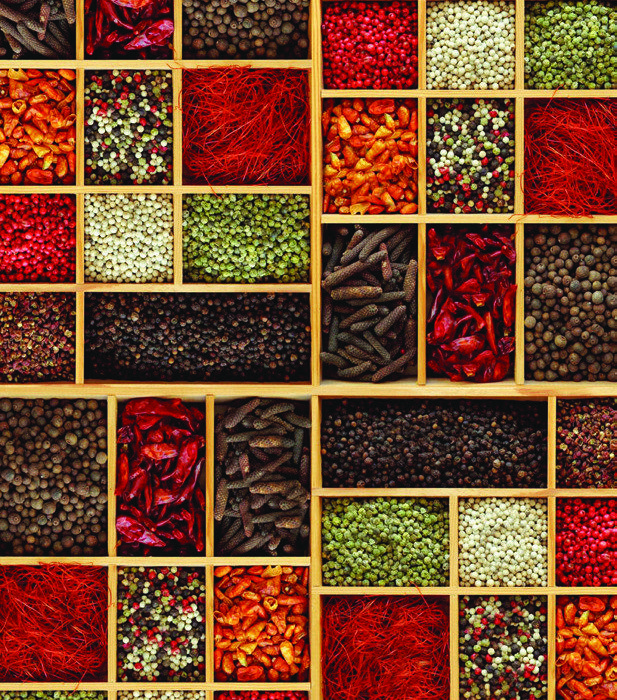The angry hiss of the oil, the clanking bangles against stainless steel, the memories and the complex emotions and politics that food brings up, writes Deepa Bhasthi.
Some stereotypes can be endearing, wouldn’t you say? In the way that filter coffee immediately brings to mind mustachioed dhoti clad men sipping copious amounts of this milky, sugary concoction out of stainless steel glasses – tumblers, as the old worlders prefer it be called – stereotypes best let us be contextualized, identified in the national milieu. Never mind that it leads to caricature and cliché. When you grow up with the clichés, you stock up nostalgia to look back upon. The rain will always remind me of the cold and of winds that wail like a banshee in the hills; literature will always remind me of grandfather’s collection of Tolstoys and Pushkins in old teakwood bookcases; lunch will always remind me of the sound of Amma’s gold bangles when they clanked against the spice box she opened, like my own magician, to conjure up a different ‘this’ and ‘that’ every day.
The Spice Box is always round, sometimes aluminum, often, in stereotypical middle class style, stainless steel. There is always another lid inside, to keep the unopened plastic packets of lesser used spices – bay leaves, nutmeg, maybe cinnamon sticks. Beneath that are seven small bowls arranged to fit in neatly. Covered by this inner lid and then shut in tight by the outer lid, these bowls brew in their own smells. Mustard seeds have a bowl for themselves, so do coriander seeds, cloves, fenugreek, white lentils, black pepper and cumin. Pale green pods of cardamom might get some space too. If they do, they will soon pucker up, open an inch and take over the box with an intoxicating fragrance. Maybe that was why Ammaput them away separately. Not that the rest of the spices behaved any better. Maybe they had a pattern, because every time the box was opened, the smell of one spice would strike first, for a bit second, before it all became mixed and confusing again.
The moment Amma started making lunch or dinner, the Spice Box would come out, rather ceremoniously, I would think, as if they knew of their important place in the scheme of things. I couldn’t be bothered by the process of cooking back then, but watching the process as if it were theatre. Food to me, still, sounds of the Spice Box – Amma’s bangles, catching the glint of the light as she brought the ensemble out; the spluttering mustard, cantankerous and almost impatient; the angry hiss of the oil when the chillies dropped in, the cackle they all made together in the large dollop of coconut oil, not unlike ‘Abracadabra’ in another language.When I think of memories, I think of how the chillies in the angry oil, indignant at the intrusion upon their selves, nevertheless allowed a fragrance that I can only describe as the smell of childhood. Like my own mistress of spices, the aftertaste of a blend of these, of shreds of coconut seeping into succulent pieces of tubers or roots or other vegetables, remind me of the performance Amma unwittingly staged every time I sat myself down in her kitchen.
* * *
My aunts have had Spice Boxes as well. These were not passed on to the daughters when they built their own kitchens. With your Amma’s blessings and some good luck, you bought a new one and infused it with your own mix of spices; some secrets were not meant to be passed on. Just like the tightly guarded secrets of those all-male teams of cooks– hired to cater at weddings, death anniversaries, house-warming ceremonies, and pujas – always remain with the cooks. Many such cooks in small towns even have a cult following, though the fans are not encouraged to watch over their shoulders. The secret of a signature rasamought not to be replicated by the housewives. Children, chasing each other around their large cauldrons were a little better tolerated; their culinary secrets were safe with the noisy lot. The cooks had to work their way through a flow chart of processes to feed 10-20 menu items to 200, 250 or a 1000 people. 
The helpers– nannies, drivers, estate workers, cleaning ladies – were relegated to a distant end of the room. Like an afterthought. After everyone else ate, they would be served by other nannies or helpers or by the caterers themselves. The catering team was lower on the social ladder than the guests, but still well above this “other-caste” lot by virtue of being born Brahmins. The rules of dining did not apply to the help. The dishes followed each other in quick succession, in no particular order. Supposedly this was because they did not eat like we do, I have heard that one often. They mix everything together anyway. They didn’t need to be given all the sweets. “They aren’t very clean now, are they?”The sacred rules, the ‘this-is-how-it-is’ section of the social pecking order passes me by, with a whooshing sound. It isn’t enough just to be born into a caste, I realize.
* * *
S comes to my parents’ house to help with the housework. For the longest time, she didn’t have a BPL card, though there were assurances from the local councilor. Now she has a card. Her expenses at the weekly vegetable market run up to a couple of hundred rupees; there are three daughters and a drunken husband she has to feed. Expenses rise every fifth week at the market. Beside her hut is a small vegetable patch, organic stuff. Every now and then she gifts me a capsicum or a few strings of beans when I visit.Her catalogue of recipes includes traditional Malabar coconut curries, unusual green vegetables, strange concoctions for treating colds, headaches and other various ailments. She grinds her spices in a stone mortar; the spices turn coarse, playing with the senses: taste, smell, touch the moaning rumble of stone against stone.… Those sounds, those smells are not something a Meenu Mixie can ever hope to replicate.
A few days ago, the Government of Karnataka announced the Anna Bhagya scheme for S’s family and nearly a crore other BPL families. She will now get 30 kilograms of rice per month at Re 1 per kilogram. Of course, the prices of oil, salt, flour, chillies, spices, everything else that make a meal, are steadily increasing. In cities, conversation begins with complaining of the price of tomatoes or peas. A union leader I know, who contests every election, be it for an MP or an MLA position, is part of the one crore category of families. His one question is whether he and his wife are to eat ganji– gruel – alone every day; with food prices this high, there isn’t much the old working class couple can afford to spice up their meals with. In a way, S, the help, is happy. Relieved rather, at these small mercies granted by the government. But the larger picture gets a shade grimmer with every passing day.
Luckily, S and her family are from a region that eats rice as a staple. The kilograms of rice at Re 1 allow her to retain some food habits at least. Unlike the family of, let’s call them the Desais, in a district in north Karnataka. I heard about them through a writer friend. For them, rice was an affair for a few festivities in a year, not a daily craving. Corn, sometimes wheat is what goes best with the hot curries they make. Rice is unpalatable. But the Karnataka government doesn’t give them that choice any longer. Corn and wheat are pricier than ever. Food prices have apparently gone up by 70 per cent in the last five years alone, so says a UN report. The Desais and their neighbours cannot afford their staples anymore, rice is in their everyday meal now. A Kannada proverb talks of how the habits of your birth don’t leave even when your body is burnt. It took a mere ambitious scheme for the government to erase the old habits of the Desais. The crisis of a food identity might not have been something the Desais would have anticipated when their crops failed and they became poor.
* * *
In this country, there is no escaping the community of the caste you are born into. In spite of my discomfort with mine, without having been given a choice, a large part of my identity is defined around the food I eat, Amma’s meals that I long for, the juicy white shreds of coconut that decorate nearly every single thing we make. That part is a caste marker as well, however much you might want to deny its origins.You grow up, you leave the hearth, you enter the melting cauldron that explains the idea of a metropolis, you get your own Spice Box, for a while you even take Instagrammed photos of the fancy places where you eat and of foods that made the childhood memories of friends. But when you lose a love, leave a job, catch a cold, you turn to your coconut, the smell of cardamom that wafts in through the back of your memory room and you find your eyes moist, for no reason, for many reasons. You seek out that place in the distant neighbourhood that purports to make authentic food of your kind food. They lie. They can never match what the mistress of spices of your particular history makes; even your own cooking is better than their purported authenticity.
You start your own theatre, you invent secrets, you smell new smells when you reach up to the last shelf in your tiny kitchen to bring out the array of spices. There is fancier glassware now, they look better than middle class steel. Yet you cannot give away the Spice Box. Some secrets are not to be passed on.














